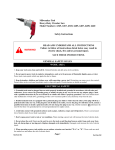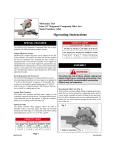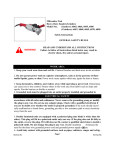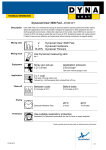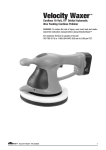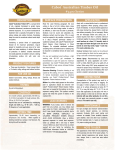Download Milwaukee 5460 Operating instructions
Transcript
Milwaukee Tool Heavy-Duty Polishers Model Numbers: 5455, 5535, 5460, 5540 Operating Instructions ASSEMBLY 1. 2. Fig. 1 WARNING! 3. To reduce the risk of injury, always unplug tool before attaching or removing accessories. Use only specifically recommended accessories. Others may be hazardous. 4. Polishing Pads (Fig. 1) MILWAUKEE Polishing Pads are available in two different materials. 100% Lambswool Pads are ideal for compounding on non-clearcoat finishes. Wool/Polyester blend Pads are softer, making them acceptable for clearcoat finishes. Refer to the chart below to select the proper Pad for your application. 5. 6. 1. To install Polishing Pads, unplug the tool and place it on its tool rest with the spindle upright. 7. 2. Make sure the washer flange and spindle washer are installed on spindle. Then, slide the disc nut through the arbor hole in both the Polishing Pad and the rubber backing pad, making sure to spread the fibers in the Pad so the disc nut seats on pad backing. 3. Push in the spindle lock button (located on left side of gear case) and simultaneously screw the disc nut & Polishing Pad assembly clockwise onto the spindle. Securely hand-tighten the disc nut and Polishing Pad. 4. To remove the Polishing Pad, push in the spindle lock button and turn the disc nut counterclockwise to unscrew the assembly. (Continued on next page) Backing Pad 8. 1. 2. 3. 4. Arbor hole Disc nut Polishing pad Rubber backing pad Spindle washer Washer flange Spindle Tool rest Polishing Pad Pad Pile Recommended Application Size Depth Surface 49-36-1450 100% Wool 7-1/2” 1-1/2” Compounding Paints, clearcoats & 49-36-1455 100% Wool 7” 2” Compounding fiberglass 49-36-2500 (7”) 49-36-0500 100% Wool/Poly. 7-1/2” 49-36-1160 100% Wool 49-36-2200 (7”) 49-36-0700 100% Wool/Poly. RenTrain INC 5. 6. 7. 8. Page 1 1-1/2” High Gloss Finishing Paints & clearcoats 9” 1-1/2” Compounding Paints, clearcoats & fiberglass 9” 1-1/2” High Gloss Finishing Paints & clearcoats RenTrain INC Operating Instructions (continued) Wool/Polyester Bonnets (Fig. 2) Refer to the chart to the right to select the proper Wool/Polyester Bonnet for your application. 1. To install Wool/Polyester Bonnets, unplug the tool and place it on a tool rest with the spindle upright. Backing Bonnets Application Pad 49-36-2500 48-48-0500 Wool/Poly High Gloss Finishing (7”) Bonnett 7” Recommended Surface Non-clearcoat or clearcoat 49-36-2200 48-48-1000 Wool/Poly High Gloss Finishing (9”) Bonnett 9” Non-clearcoat or clearcoat 2. Make sure the washer flange and spindle washer are installed on spindle. Then, slide the rubber backing pad onto the spindle. 3. Push in the spindle lock button and screw the disc nut onto the spindle clockwise. Securely hand-tighten the disc nut. 4. Cover the rubber backing pad with the Bonnet. Securely tie Bonnet strings and tuck the strings into the Bonnet so they do not interfere with polishing. 5. To remove, untie and remove the Bonnet. Push in the spindle lock button and turn the disc nut and rubber backing pad counterclockwise. Fig. 2 Hook and Loop Pads (Fig. 3) Hook & Loop Pads are available in both Wool/Polyester and Foam. Foam Pads are not recommended for use with high speed Polisher No. 5535 because they may bum through the paint. Foam Pads should be used on slower/low speed dial settings when using Polisher Nos. 5540 and 5460. Foam Pads are not recommended for the inexperienced operator. Foam Pad No. 49-36-1550 is ideal for use with clearcoat finishes and microfine rubbing compounds. It will remove light surface scratches, environmental pollutants, wet-sanding scratches and hazy paint. (Continued on next page) 1. Fig. 3 1. 2. 2. 3. 3. 4. 4. 5 5. 6. 6. 7. 7. 8. 1. Disc nut 2. Wool/Polyester bonnet 3. Bonnet strings 4. Rubber backing pad RenTrain INC 5. Spindle washer 6. Washer flange 7. Spindle 8. Tool rest 1. Foam pad w/ hook & loop 2. Centering tool (remove before using tool) 3. Backing pad w/ hook & loop Page 2 4. Spindle washer 5. Washer flange 6. Spindle 7. Tool rest RenTrain INC Operating Instructions (continued) Foam Pad No. 49-36-0650 is ideal for glazing and finBacking Pad Hook & Loop Pad ishing on clearcoat finishes. It will remove buffing 49-36-1500 100% Wool Pad swirls, hard water spots, carwash brush swirls and 4936-0600 mild hazing. A Centering Wool Blend Pad Tool, Catalog No. 49-36-2150 49-67-0130, is supplied 49-36-1550 Foam Pad with Hook and Loop Backing Pads, Catalog No. 49-36-2150, to properly align the backing pad 4936-0650 Foam Pad with the polishing pad, providing the proper balance for your Polisher. Refer to the chart at right to select the right Hook & Loop Pad for your application. Fig. 4 A Centering Tool, Catalog No. 49-67-0130, is supplied with Hook and Loop Backing Pads, Catalog No. 49-36-2150, to properly align the backing pad with the polishing pad, providing the proper balance for your Polisher. 1. To install Hook and Loop Pads, unplug the tool and place it on tool rest with spindle upright. Application Compounding Recommended Surface Paints, clearcoats and fiberglass High Gloss Finishing Paints or clearcoats Compunding Clearcoat High Gloss Finish Clearcoat 1. 2. Make sure washer flange and spindle washer are installed on spindle. Then slide Hook and Loop backing pad onto spindle. 3. Push in the spindle lock button and spin the backing pad clockwise until it is securely hand-tightened. 4. Insert the Centering Tool (supplied with the backing pad) into the center hole in the Hook and Loop backing pad. Push desired Hook and Loop Polishing Pad over the Centering Tool so that the Polishing Pad fastens to the Hook and Loop backing pad. Remove Centering Tool. 5. To remove, “peel” off the Polishing Pad. Push in the spindle lock button and rotate backing pad counterclockwise to remove. 1. 1. Speed control dial NOTE: Use side handles for better control and safety. 2. Trigger OPERATION WARNING! To reduce the risk of injury, always unplug tool before attaching or removing accessories. Use only specifically recommended accessories. Others may be hazardous. Starting, Stopping and Controlling Speed (Fig. 4) Catalog Nos. 5535 & 5455: To start the tool, pull the trigger. To stop the tool, release the trigger. Catalog Nos. 5540 & 5460 feature a dial speed control, which controls the polisher’s maximum rotations per minute. The speed will remain variable to the chosen dial setting by use of the trigger switch. Dial settings range from numbers 1 through 5. Lower numbers correspond to lower speeds and higher numbers correspond to higher speeds. Generally, lower speeds are recommended for fight work areas and higher speeds are ideal for large surface areas. Use the setting that best suits your job. To control the speed, setthe dial to the desired number. Then pull the trigger. Increase or decrease pressure on the trigger to vary the speed. To stop the tool, release the trigger. (Continued on next page) RenTrain INC Page 3 RenTrain INC Operating Instructions (continued) Polishing Always use side handle for proper control. Move the Polisher back and forth in long, sweeping strokes. Too much pressure, the wrong angle or improper motion may cause swirl marks or burning. For detailed polishing instructions, read the instructions provided with your finishes, waxes and polishes. Preventing Burning Through Paint It is easy to burn through the paint on a surface. This can occur if you polish at too high a speed or if you allow the polishing pad to stay in one spotforeven a short period of time. To prevent burning through paint, use very light pressure and keep the polisher moving constantly, especially when working near edges or where there are abrupt changes in the contour of the work surface. Be particularly careful when using Catalog Nos. 5535 and 5540, which are high RPM Polishers and are more likely to bum through paint. Preventing Snagging Snagging occurs when polishing pads get caught on rough edges of a work surface. Snagging can cause the tool to suddenly “kick back” and it may cause the pad to bum through the paint. To reduce the risk of snagging, use the polisher at low speeds when polishing rough surfaces. For tricky areas such as near trim or between a mirror and window on a car, do not take chances with a polisher. Polish these surfaces by hand. When using Catalog Nos. 5460 and 5540 with the Trigger Speed Control, release the trigger slightly so the rotation of the pad is slowed. To prevent snagging while using Catalog Nos. 5455 and 5535 without Trigger Speed Control, it is best to use the “coast-down” technique to avoid snagging. To coast-down, turn the motor ON for a few seconds, then turn it OFF and apply the polishing pad to the surface. This way, when the pad touches the work surface, it will be rotating more slowly than it is when the motor is ON. Use coast-down when working in areas where crevices or pockets are present. WARNING! WARNING! To reduce the risk of injury, keep the cord set away from the path of the polisher. Otherwise the cord set may become caught by the pad and wrap around the s pindle; this may cut through the cord and expose live wires or make the gear box electrically “live.” RenTrain INC To reduce the risk of injury, follow instructions for preventing snagging. Snagging may cause the tool to kick back and the operator to suddenly lose control of the tool. Always use side handle to maintain control. Page 4 RenTrain INC




